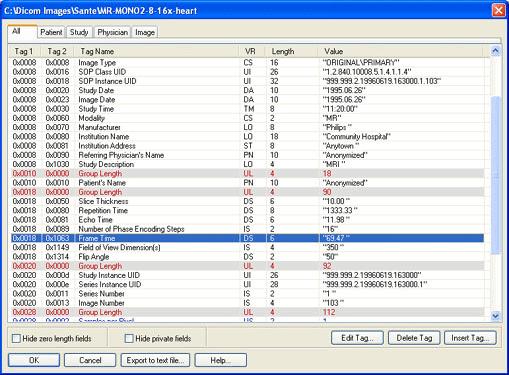Today, images obtained from standard clinical MR scanners are nearly always stored in Picture Archiving and Communications Systems (PACS). PACS store the image data, as well as a other demographic and technical information in a format known as DICOM (Digital Imaging and Communication in Medicine).
The DICOM standard was developed in 1990's as a joint collaboration between the American College of Radiology (ACR) and the National Electrical Manufacturers Association (NEMA). The DICOM file contains a header (that stores patient's name, age, sex, type of scan, image dimensions, etc) as well as all of the image data (that can contain information in three dimensions). The current DICOM standard is widely accepted among major vendors, and for storing and transferring relatively simple image data works very efficiently.
Unfortunately, there is no widely accepted DICOM standard for a large number of complex MR data sets, such as those generated using functional MRI, MR spectroscopy, perfusion imaging, and the like. This "unconventional" raw data is either: 1) "scrubbed" (stripped) and not transferred to PACS, or 2) stored in a proprietary format defined by so-called private fields of the DICOM metadata header.
Thus it is very common not to be able access or reprocess important functional MR data if only a clinical PACS has been used to store the data obtained. A separate storage system for this specialized data may be necessary.
The DICOM standard was developed in 1990's as a joint collaboration between the American College of Radiology (ACR) and the National Electrical Manufacturers Association (NEMA). The DICOM file contains a header (that stores patient's name, age, sex, type of scan, image dimensions, etc) as well as all of the image data (that can contain information in three dimensions). The current DICOM standard is widely accepted among major vendors, and for storing and transferring relatively simple image data works very efficiently.
Unfortunately, there is no widely accepted DICOM standard for a large number of complex MR data sets, such as those generated using functional MRI, MR spectroscopy, perfusion imaging, and the like. This "unconventional" raw data is either: 1) "scrubbed" (stripped) and not transferred to PACS, or 2) stored in a proprietary format defined by so-called private fields of the DICOM metadata header.
Thus it is very common not to be able access or reprocess important functional MR data if only a clinical PACS has been used to store the data obtained. A separate storage system for this specialized data may be necessary.
Advanced Discussion (show/hide)»
No supplementary material yet. Check back soon!
References
The Official DICOM Website. Information and updates, as well as complete/detailed standards can be downloaded here. Section 10 (pdf) is most applicable to MRI data storage formats.
The Official DICOM Website. Information and updates, as well as complete/detailed standards can be downloaded here. Section 10 (pdf) is most applicable to MRI data storage formats.
Related Questions
What are the steps a technologist goes through to perform an MRI scan?
What are the steps a technologist goes through to perform an MRI scan?

